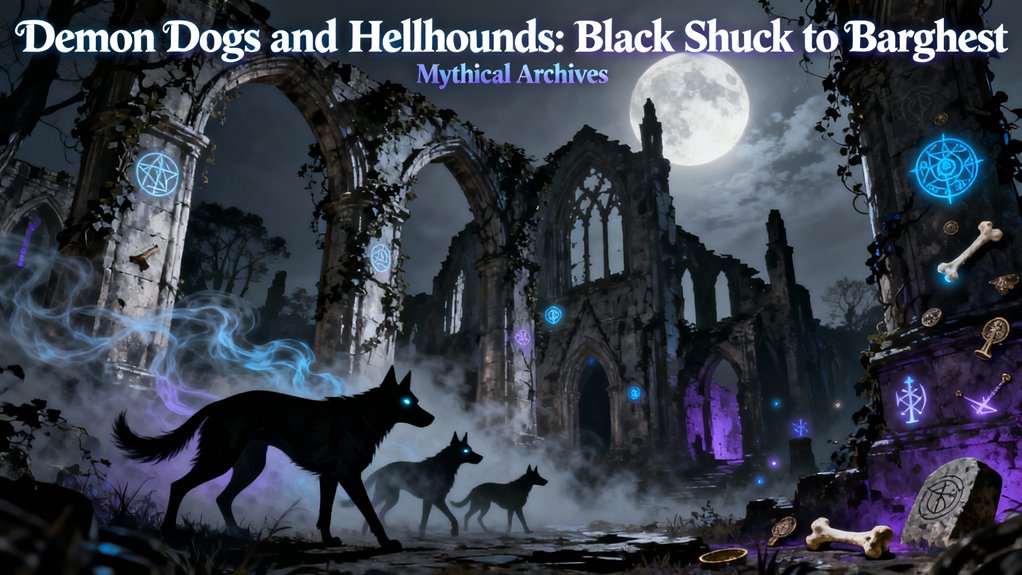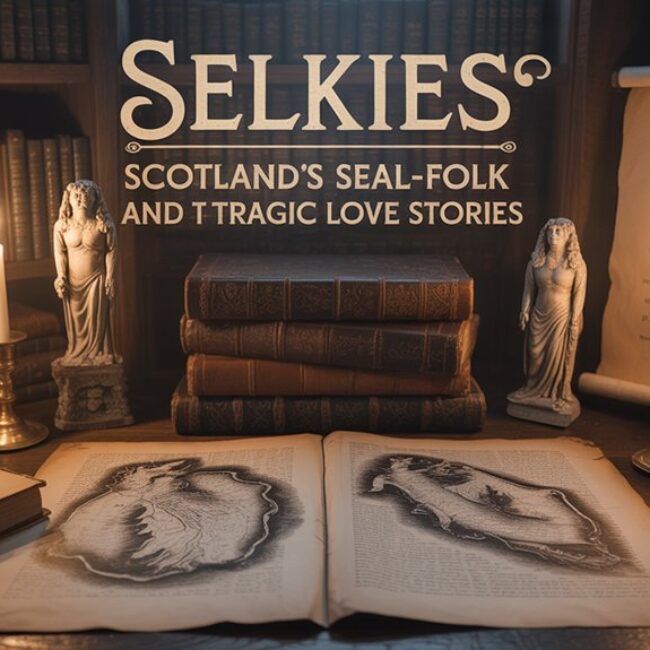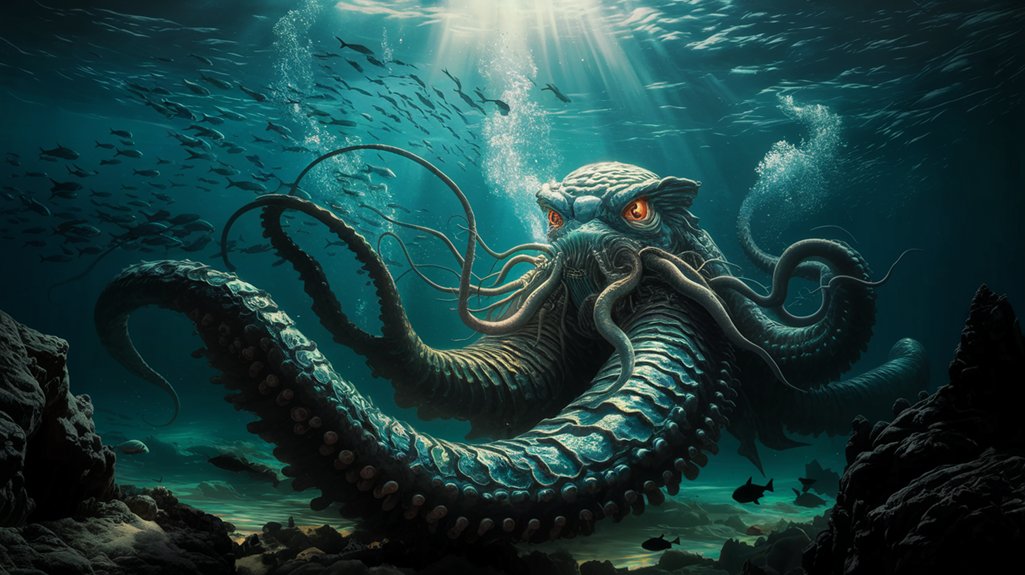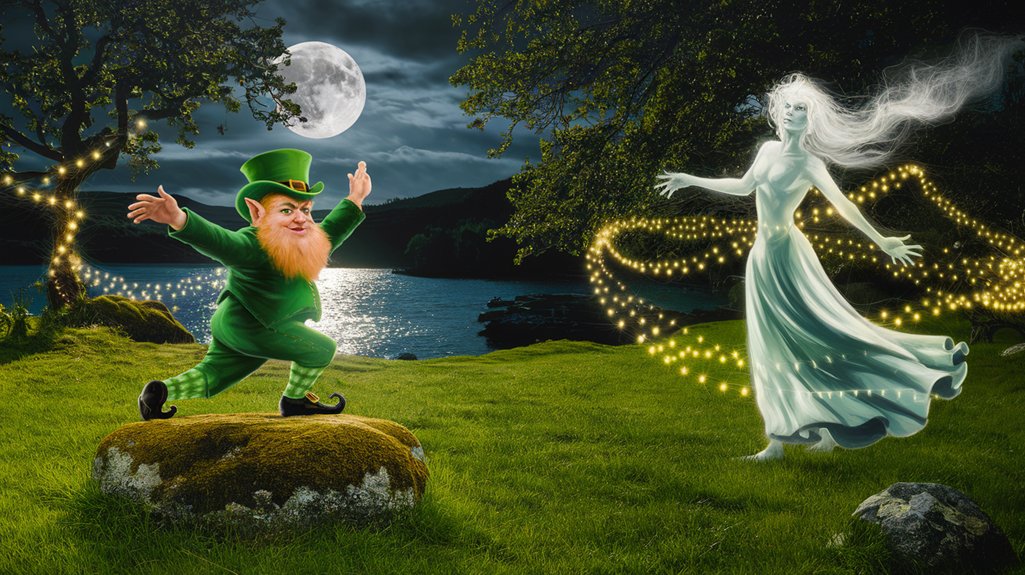You'll find Britain's spectral hounds documented across nine centuries—from Black Shuck's burning-eyed manifestation at Blythburgh's Holy Trinity Church in 1577 to Yorkshire's shape-shifting Barghest and Lancashire's crossroad-haunting Gytrash. These eldritch canines, derived from Old English “scucca” (demon), share consistent features: coal-like luminous eyes, dimensions exceeding natural anatomy, and appearances near pre-Christian burial sites along ancient Roman roads. Their Celtic origins as Cŵn Annwn—otherworldly psychopomps—reveal deeper cultural truths about Britain's liminal spaces, where twenty-first century witnesses continue reporting encounters that challenge accepted boundaries between flesh and spirit.
Key Takeaways
- Black Shuck, deriving from Old English “scucca” (demon), is East Anglia's phantom hound with burning eyes and coal-black fur.
- Yorkshire's Barghest is a malevolent shape-shifter with saucer-sized eyes that foretells death and transforms into various forms.
- Spectral hounds share common traits: glowing eyes, massive size exceeding natural canines, and appearances near ancient roads and burial sites.
- These hellhounds originated in Celtic and Germanic traditions as psychopomps and otherworld guardians before becoming death omens.
- Regional variants include Lancashire's Gytrash and Welsh Gwyllgi, each manifesting uniquely at crossroads, storms, and cultural boundary locations.
The Legend of Black Shuck: Suffolk's Most Feared Phantom

Along the windswept coasts and fog-shrouded heaths of Suffolk, no spectral entity commands greater dread than Black Shuck—a phantom hound whose very name derives from the Old English “scucca,” meaning demon or devil.
🎯 Recommended Products
Handpicked items related to this article:
As an Amazon Associate, we earn from qualifying purchases.
Black Shuck—the demon hound of Suffolk—emerges from Old English darkness, a phantom whose name itself whispers of devils and dread.
You'll find this eldritch creature woven throughout East Anglian folklore since medieval times, its presence marked by eyes like burning coals and fur blacker than starless nights.
The most documented encounter occurred on August 4, 1577, when Black Shuck allegedly burst through Holy Trinity Church in Blythburgh, killing two parishioners and leaving scorch marks still visible today.
Ghostly sightings persist along coastal paths and ancient trackways, where witnesses report encountering a chimeric beast larger than any natural hound.
You're confronting more than superstition here—you're facing centuries of collective memory, passed down through generations who understood that certain thresholds between worlds remain permeable.
Black Shuck represents England's untamed past, refusing domestication by modern rationality.
Regional Variants: From Barghest to Gytrash Across the British Isles
You'll discover that Britain's spectral hounds manifest in eldritch variations across distinct regional landscapes, each chimeric entity bearing its own nomenclature and particular modes of supernatural dread.
Yorkshire's Barghest stalks the moorlands with shape-shifting malevolence—sometimes appearing as a monstrous black dog with eyes like burning coals, other times assuming human or even ursine form—while Lancashire's Gytrash haunts lonely pathways, documented in eighteenth-century parish records and travelers' accounts as a harbinger of misfortune.
The geographic distribution of these entities reveals a fascinating pattern: hellhound sightings concentrate along ancient Roman roads, pre-Christian burial sites, and liminal zones where tended land surrenders to wilderness.
Yorkshire's Fearsome Barghest Legend
While scholars trace the earliest written accounts of Yorkshire's barghest to the sixteenth century, the creature's origins stretch far deeper into the mist-shrouded moorlands of northern England, where generations of villagers whispered warnings about a shapeshifting demon that prowled ancient Roman roads and limestone valleys after nightfall. Yorkshire folklore presents this eldritch sentinel as chimeric—sometimes appearing with eyes like burning coals, other times manifesting chains that herald approaching death.
| Barghest Characteristics | Manifestation Details |
|---|---|
| Primary Form | Massive black dog with saucer-sized eyes |
| Alternative Shapes | Headless man, white rabbit, horse |
| Warning Signs | Rattling chains, sulfurous odor |
| Associated Locations | Troller's Gill, Leeds bridges, York's ancient gates |
| Death Omen | Direct sighting foretells doom within year |
You'll find this Yorkshire folklore deeply embedded in place-names and local consciousness.
Lancashire Gytrash Encounters Documented
Cross the Pennine ridge westward into Lancashire, and the barghest's shadowy cousin emerges from different soil—the gytrash, a spectral hound whose documented encounters span three centuries of written testimony and oral tradition.
Encounter reports from 1740 onward describe a chimeric entity manifesting as dog, horse, or mule, materializing at crossroads where choices fracture destiny.
Parish records preserve gytrash sightings near Burnley's moorland edges, where witnesses reported eyes burning like forge-coals through evening mist.
The creature's eldritch nature defies singular classification. Unlike Yorkshire's death-portending barghest, Lancashire's gytrash serves as guardian and omen, leading lost travelers homeward or blocking dangerous paths.
You'll find these accounts preserved in county archives, handwritten testimonies documenting something prowling beyond rational explanation, something ancient watching from Lancashire's liminal margins.
Geographic Distribution Patterns Analyzed
Seven distinct regional variants of spectral hounds map across the British Isles, each territory claiming sovereignty over its particular manifestation of canine otherworld.
You'll find Black Shuck prowling East Anglia's coastlines, while Yorkshire's Barghest haunts forgotten crossroads with chimeric intensity.
Lancashire claims the Gytrash, that eldritch sentinel of moorland paths. Geographic variations reveal cultural boundaries: Scotland's Cù Sìth emerges green-furred from highland mists, Wales harbors the Cŵn Annwn with their blood-red ears, and Ireland's Pooka shifts forms across Connacht's limestone karst.
Regional folklore demonstrates sophisticated territorial distinctions—each phantom hound reflects its landscape's character, from fenland to fell.
These geographic variations aren't random; they're ancient markers of tribal boundaries, ecclesiastical jurisdictions, dialect zones. The map speaks.
Common Characteristics: Burning Eyes, Massive Forms, and Spectral Appearances
You'll find that across disparate mythological traditions—from the Celtic barghest to the Germanic Schwarzer Hund, from Greco-Roman Cerberus to the Mesoamerican cadejo—these eldritch canines manifest certain unmistakable attributes that transcend geographical and temporal boundaries.
Their eyes, invariably described as burning coals, sulfurous flames, or lambent crimson orbs that pierce darkness itself, serve as the primary marker of their otherworldly nature; witnesses from medieval Yorkshire to twentieth-century Appalachia report this same terrible luminescence.
The creatures‘ physical dimensions defy natural law: massive shoulders reaching a man's chest, bodies as large as calves or small horses, paws that leave scorched impressions in earth and stone.
Glowing Eyes Across Cultures
When witnesses throughout history attempt to describe encounters with supernatural canines, they gravitate toward one singular feature with remarkable consistency: the eyes. These burning orbs transcend mere physical description, embodying cultural symbolism that varies across continents yet maintains an eldritch coherence. You'll find mythological interpretations diverging in nuance while converging in fundamental nature—eyes that pierce reality's veil.
| Culture | Eye Description | Symbolic Meaning |
|---|---|---|
| British Isles | Crimson flames | Death's approach |
| Germanic | Sulfurous yellow | Demonic origin |
| Latin American | Green phosphorescence | Wayward souls |
Whether crimson, amber, or spectral green, these luminous gazes serve identical purposes: marking boundaries you shouldn't cross, warning of chimeric dangers lurking beyond civilization's fragile borders. The eyes don't merely see—they judge, penetrate, condemn.
Size and Physical Descriptions
Beyond the hypnotic luminescence of their gazes, these supernatural hounds manifest physical dimensions that defy natural taxonomy—creatures whose very proportions assault conventional understanding of canine anatomy.
You'll encounter size variations spanning from mastiff-scale beasts to entities rivaling cart-horses, their chimeric forms documented across medieval chronicles and Victorian testimonies. Black Shuck's witnesses reported shoulders reaching a man's chest height.
The Barghest's physical traits proved even more eldritch—observers describing limbs elongated beyond mammalian possibility, spectral flesh that shifted between corporeal and vaporous states.
These manifestations resist taxonomic classification. Some accounts detail shaggy pelts absorbing ambient light; others describe hairless, shadow-wrought forms.
The Church Grim materialized smaller yet equally unnatural. Physical consistency matters less than transgressive presence—beings whose very existence challenges your accepted boundaries between flesh and spirit, natural and supernatural.
Historical Accounts and Documented Sightings Through the Centuries
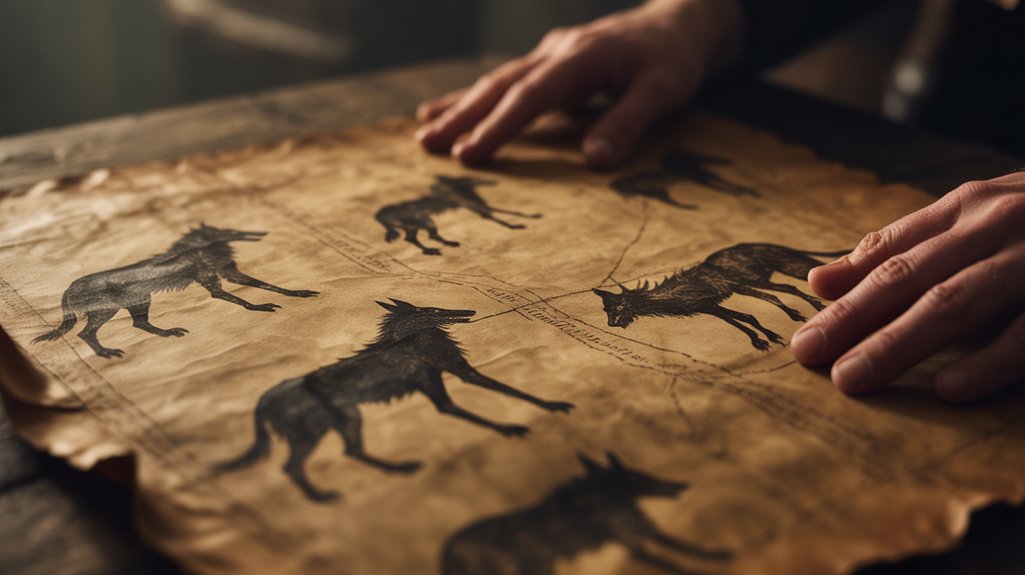
Although folklore tends to blur chronology into timeless myth, the historical record preserves specific encounters with demon dogs that anchor these creatures firmly in documented time.
Beyond folklore's hazy veil, demon dog encounters exist as tangible historical events—documented, dated, and disturbingly real.
You'll discover that historical sightings emerge from monastery chronicles, parish records, and witness testimonies spanning centuries—each documented encounter offering tangible proof of humanity's persistent brush with the eldritch.
Consider these pivotal recorded manifestations:
- 1127 CE – Peterborough Chronicle details spectral hounds haunting English forests during King Henry's reign
- 1577 – Black Shuck's devastating appearance at Bungay church, Suffolk, leaving claw marks still visible today
- 1850 – Yorkshire mining communities report barghest sightings preceding colliery disasters
- 1905 – Welsh parish registers document gwyllgi encounters near ancient burial grounds
- 1938 – Norfolk coastal witnesses provide sworn testimonies of phantom hounds during storm-wracked nights
These aren't chimeric fabrications. They're historical sightings bearing names, dates, locations—evidence you can't dismiss when freedom means confronting uncomfortable truths about reality's permeable boundaries.
Ancient Origins: Celtic Mythology, Folklore, and Possible Pre-Christian Roots
Before Christianity's ecclesiastical dominance reshaped Britain's spiritual landscape, the Celts recognized creatures dwelling at civilization's threshold—beings neither wholly animal nor spirit, but something fundamentally *other*.
These eldritch guardians patrolled boundaries between worlds, their chimeric forms embodying alteration itself.
Celtic connections run deep through hellhound mythology. The Cŵn Annwn—white-bodied hounds with crimson ears—served Arawn, lord of Annwn's otherworld.
You'll find their howls described as inversely proportional to proximity: loudest when distant, whisper-soft when near. This acoustic paradox exemplified Celtic understanding of reality's mutable nature.
Folklore influences predating Christian demonization reveal these creatures as psychopomps rather than tormentors. They guided souls, maintained cosmic order, protected sacred spaces.
Germanic tribes contributed their own traditions—spectral hunt participants, storm-heralds, boundary-keepers between tended land and wilderness.
Pre-Christian peoples didn't fear these beings. They respected them. Understood their necessary function. Recognized power without imposing moral absolutes.
These spectral hounds shared conceptual territory with numerous mythical creatures in Celtic lore, each embodying specific aspects of the supernatural world's complex taxonomy.
Death Omens and Supernatural Powers Attributed to Phantom Hounds
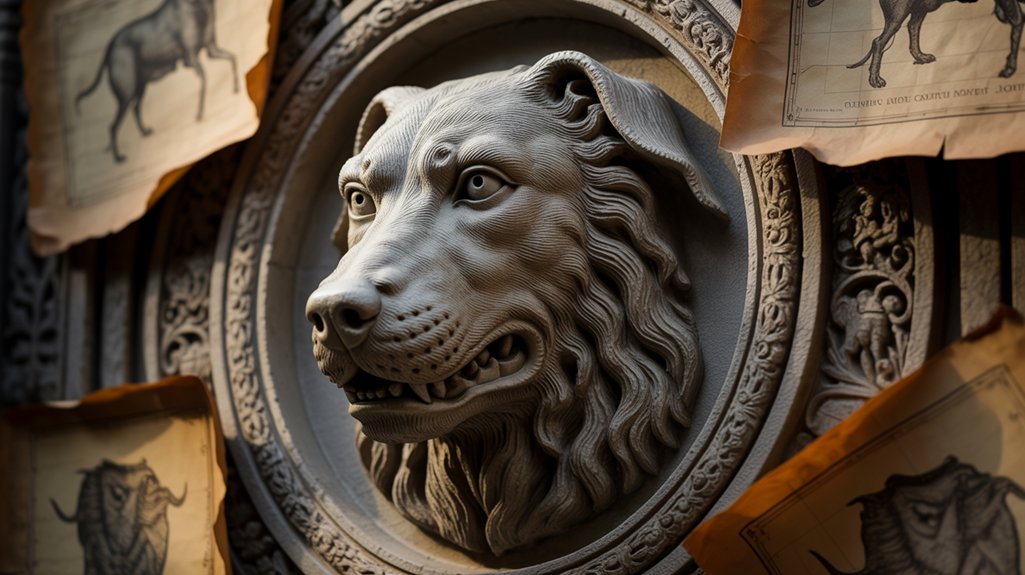
When phantom hounds manifest in village squares or crossroads at midnight, death invariably follows—not as punishment, but as proclamation.
These eldritch harbingers possess powers surpassing mortal comprehension, their very presence rupturing the membrane between worlds.
Supernatural encounters with these creatures reveal consistent abilities:
- Corporeal shapeshifting: altering from massive beasts to dissipating mist within heartbeats
- Prophetic manifestation: appearing precisely three days before a community member's demise
- Spectral combustion: leaving scorched earth where paws touched ground, smoke rising without flame
- Psychic paralysis: freezing witnesses through direct eye contact, inducing cataleptic states
- Dimensional traversal: vanishing through solid walls, defying physical laws
You'll find these chimeric entities neither seek nor require your permission to appear.
They operate beyond human jurisdiction, answerable only to ancient contracts binding them to specific bloodlines, territories, particular crossroads.
Death omens made flesh. The phantom hounds don't threaten—they announce what's already written.
Modern Encounters and the Enduring Cultural Legacy of Britain's Hellhounds
Twenty-first century Britain harbors more hellhound sightings than Victorian England ever recorded, despite our supposed age of empiricism and technological omniscience.
You'll find modern sightings clustered along ancient ley lines—Suffolk's coastal paths, Yorkshire's moors, Lancashire's fog-shrouded byways—where chimeric hounds manifest with disturbing regularity. Witnesses describe eldritch encounters: luminous eyes piercing motorway darkness, spectral forms traversing abandoned railways, massive paw prints appearing overnight in suburban gardens.
The cultural impact reverberates through contemporary literature, cinema, folklore societies dedicated to preserving these traditions as living heritage rather than quaint superstition.
Your smartphone won't capture them. Digital cameras malfunction.
Britain's hellhounds endure because they represent something technology can't banish: liminal guardians between worlds, death omens altered into cultural touchstones.
These creatures refuse obsolescence, adapting to modernity while maintaining their primal essence. They patrol boundaries—geographical, temporal, metaphysical—reminding you that ancient knowledge persists beneath progress's veneer, waiting in the darkness beyond streetlamps.
Frequently Asked Questions
Are Demon Dogs and Hellhounds Based on Real Animal Species?
You'll find these eldritch guardians rooted in actual canine species—wolves, primarily, whose nocturnal howls and predatory animal behavior haunted medieval consciousness.
Their mythical origins stem from humanity's primal fear of Canis lupus, altered through cultural memory into something chimeric, supernatural.
Ancient peoples observed genuine pack interactions, glowing tapetum lucidum in darkness, and territorial aggression, then wove these traits into spectral hounds.
Real wolves became templates for otherworldly manifestations, their essence distilled into legend.
How Do You Protect Yourself From a Hellhound Encounter?
You'll need protective charms—iron talismans, rowan crosses, salt circles—to ward off these eldritch creatures.
Traditional folklore demands you avert your gaze; direct eye contact invites doom.
Spiritual cleansing through sacred herbs like vervain and mugwort strengthens your defenses against hellhound manifestations.
Medieval grimoires prescribed prayers to Saint Christopher, patron against dark beasts.
Should you encounter one during liminal hours, retreat without running.
These chimeric entities feed on fear, drawn to those who acknowledge their presence through panic or flight.
Do Other Countries Have Similar Black Dog Legends?
You'll discover black dog folklore spans continents, revealing humanity's shared fascination with these eldritch guardians.
While Britain's Shuck prowls coastal moors, Germany's Höllenhund stalks medieval crossroads, Mexico's Cadejo—split between benevolent white and malevolent black—protects nighttime travelers.
International variations emerge from Connecticut's Hooter to Wales's Gwyllgi, each culture weaving localized supernatural canines into their landscape's fabric.
These chimeric entities transcend borders, their dark forms materializing wherever ancient paths meet human consciousness, whispering truths about our collective fear of darkness incarnate.
Can Hellhounds Be Photographed or Recorded With Modern Technology?
You'll find no verified photographic evidence of hellhounds, despite modern surveillance capabilities.
These eldritch entities exist beyond technological limitations—spectral manifestations that resist digital capture, their chimeric forms dwelling in liminal spaces where electromagnetic frequencies falter.
Witnesses report camera malfunctions, corrupted footage, inexplicable static.
The phenomenon suggests these creatures inhabit dimensions perpendicular to our material plane, their essence incompatible with mechanical observation.
They're bound to ancient pathways, seen only when they choose revelation.
What Should You Do if You See a Phantom Hound?
If you encounter such an eldritch apparition, remain still, avert your gaze, show respect—the folklore origins demand reverence, not confrontation.
Don't run. Don't provoke. Don't photograph these liminal guardians of thresholds and boundaries.
In phantom encounters across British Isles traditions, stillness preserves life; curiosity invites doom. Move backward slowly, acknowledge the creature's ancient sovereignty over these borderlands.
Your freedom depends on recognizing you've trespassed into chimeric territories where mortal authority dissolves, where old laws supersede modern confidence.
Conclusion
You've traced these eldritch guardians through centuries of mist-shrouded testimony, from Black Shuck's burning gaze to the Barghest's chimeric form. Like shadows lengthening at dusk, their presence stretches across Britain's collective memory—neither wholly corporeal nor entirely spectral. Whether you encounter these phantom hounds as folklore's remnant or something darker lingering in liminal spaces, they remain what they've always been: harbingers standing sentinel between the known world and whatever lies beyond.
